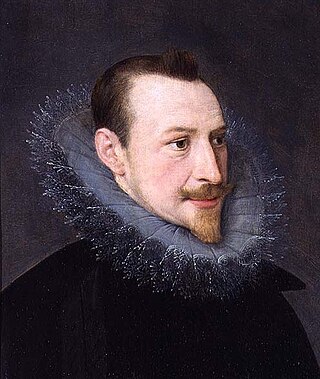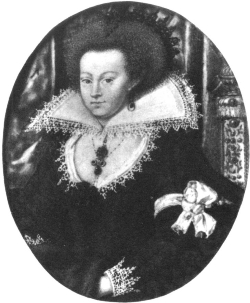Related Research Articles

Edmund Spenser was an English poet best known for The Faerie Queene, an epic poem and fantastical allegory celebrating the Tudor dynasty and Elizabeth I. He is recognized as one of the premier craftsmen of nascent Modern English verse, and he is considered one of the great poets in the English language.

The Faerie Queene is an English epic poem by Edmund Spenser. Books I–III were first published in 1590, then republished in 1596 together with books IV–VI. The Faerie Queene is notable for its form: at over 36,000 lines and over 4,000 stanzas, it is one of the longest poems in the English language; it is also the work in which Spenser invented the verse form known as the Spenserian stanza. On a literal level, the poem follows several knights as a means to examine different virtues. The poem is also an allegorical work. As such, it can be read on several levels, including as praise of Queen Elizabeth I. In Spenser's "Letter of the Authors", he states that the entire epic poem is "cloudily enwrapped in Allegorical devices", and that the aim of publishing The Faerie Queene was to "fashion a gentleman or noble person in virtuous and gentle discipline".
This article presents lists of literary events and publications in the 16th century.
This article contains information about the literary events and publications of 1754.
This article lists notable literary events and publications in 1599.
This article contains information about the literary events and publications of 1598.
This article is a summary of the literary events and publications of 1595.
This article presents lists of the literary events and publications in 1590.

Elizabethan literature refers to bodies of work produced during the reign of Queen Elizabeth I (1558–1603), and is one of the most splendid ages of English literature. In addition to drama and the theatre, it saw a flowering of poetry, with new forms like the sonnet, the Spenserian stanza, and dramatic blank verse, as well as prose, including historical chronicles, pamphlets, and the first English novels. Major writers include William Shakespeare, Edmund Spenser, Christopher Marlowe, Richard Hooker, Ben Jonson, Philip Sidney, Thomas Kyd, and Richard Barnfield.
David Lee Miller is a scholar of English Renaissance Literature. He is Distinguished Professor of English and Comparative Literature at the University of South Carolina in Columbia. His works include The Poem's Two Bodies: The Poetics of the 1590 Faerie Queen, ; Dreams of the Burning Child: Sacrificial Sons and the Father's Witness ; three edited books; and about two dozen refereed articles that have appeared in scholarly journals such as Modern Language Quarterly, English Literary History, and Publications of the Modern Language Association. He is one of four general editors of The Collected Works of Edmund Spenser, a new scholarly edition under contract to Oxford University Press.
Nationality words link to articles with information on the nation's poetry or literature.
— Last lines from William Shakespeare's Sonnet 18, published this year and, four centuries later, still "eternal lines"

William Ponsonby was a prominent London publisher of the Elizabethan era. Active in the 1577–1603 period, Ponsonby published the works of Edmund Spenser, Sir Philip Sidney, and other members of the Sidney circle; he has been called "the leading literary publisher of Elizabethan times."
Events from the 1590s in England.
John Upton was an English clergyman, academic and critic. An important early editor of Edmund Spenser, he is best known for the notes in his 1758 edition of Spenser's great romance epic The Faerie Queene, which was first published in 1590 and 1596.
— From Sir John Harington, A New Discourse of a Stale Subject, called the Metamorphosis of Ajax
Nationality words link to articles with information on the nation's poetry or literature.

Elizabeth Spencer, Baroness Hunsdon was an English noblewoman, scholar, and patron of the arts. She was the inspiration for Edmund Spenser's Muiopotmos, was commemorated in one of the poet's dedicatory sonnets to The Faerie Queene, and was represented as "Phyllis" in the latter's pastoral poem Colin Clouts Come Home Againe. She herself translated Petrarch. Her first husband was George Carey, 2nd Baron Hunsdon, grandson of Mary Boleyn, elder sister of Anne Boleyn, mother of Queen Elizabeth I.
Naseeb Azeez Shaheen was an American scholar who specialized in Biblical allusions in the work of Shakespeare.
Events from the year 1596 in France
References
- ↑ A. C. Hamilton (11 June 2014). Spenser: The Faerie Queene. Routledge. p. 19. ISBN 978-1-317-86564-3.
- ↑ William Harrison; Georges Edelen (1 January 1994). The Description of England: The Classic Contemporary Account of Tudor Social Life. Courier Corporation. p. 3. ISBN 978-0-486-28275-6.
- ↑ Purcell, Mark (2002). "Warfare and Collection-Building: The Faro Raid of 1596". Library History. 18: 17–24. doi:10.1179/lib.2002.18.1.17. S2CID 143627314.
- ↑ Ovenden, Richard (2020). Burning the Books. John Murray. ISBN 9781529378757.
- ↑ 宏观語言學. Household World Publisher. 1992. p. 91.
- ↑ McGraw-Hill Encyclopedia of World Drama: An International Reference Work in 5 Volumes. VNR AG. 1984. p. 95. ISBN 978-0-07-079169-5.
- ↑ John Cottingham (25 September 1992). The Cambridge Companion to Descartes. Cambridge University Press. p. 22. ISBN 978-0-521-36696-0.
- ↑ Alexander Chalmers (1812). The General Biographical Dictionary. p. 146.
- ↑ Encyclopaedia Britannica: A Dictionary of Arts, Sciences, and General Literature. R.S. Peale. 1891. p. 417.
- ↑ Bernhard Maier (2009). William Robertson Smith: His Life, His Work and His Times. Mohr Siebeck. p. 91. ISBN 978-3-16-149995-1.
- ↑ Madeleine de l'Aubespine (15 September 2008). Selected Poems and Translations: A Bilingual Edition. University of Chicago Press. p. 9. ISBN 978-0-226-14195-4.
- ↑ Howell A. Lloyd (2017). Jean Bodin: 'this Pre-eminent Man of France' : an Intellectual Biography. Oxford University Press. p. 239. ISBN 978-0-19-880014-9.